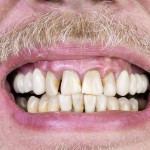
The clinical manifestations of aggressive periodontitis and chronic periodontitis differ and microbiological and immunological hypotheses have been advanced to explain the differences. The aim of this review was to assess whether patients with aggressive periodontitis have different cytokine/chemokine profiles to those with chronic periodontitis.
Methods
Searches were conducted in the PubMed/Medline and Embase databases. Human studies involving cytokine/chemokine analyses of the gingival cervicular fluid with direct comparison of localized or generalized aggressive periodontitis with chronic periodontitis were considered. Only English language studies were considered. Two reviewers independently selected studies and data abstracted using pre-defined worksheets.
Results
- 17 studies involving a total of 843 patients were included.
- 370 patients had aggressive periodontitis and 437 chronic periodontitis
- The mean age of in all 17 studies, ranged between 30.2 and 52.5 years for those with chronic periodontitis and 26.07 and 32 years for those with aggressive periodontitis.
- Commercial immunoenzymatic assay (ELISA) kits were used for cytokine/chemokine assessments in almost all studies
- 21 different cytokines/chemokines were analyzed [IL-1b, IL-2, IL-4, IL-6, IL-8, IL-10, IL-11, IL-17, IL-29, TNF-a, IFN-c, trans- forming growth factor- b1 (TGF-b1), RANKL, osteprotegerin (OPG), C-C motif chemokine ligand (CCL) 28, oncostatin (OSM), leukemia inhibitory factor (LIF), endothelial-monocyte activating polypeptide (EMAP)-II, MIP-1a, MIP-1b and MCP-1)].
- 5 studies demonstrated that the gingival cervicular fluid levels of some cytokines/chemokines, mainly those related to proinflammation, were increased in aggressive periodontitis compared with chronic periodontitis.
- 3 studies observed that the gingival cervicular fluid levels of cytokines with anti-inflammatory properties were lower in subjects with aggressive periodontitis than in subjects with chronic periodontitis.
- A majority of studies did not find any significant differences in cytokine/chemokine levels between patients with aggressive periodontitis and those with chronic periodontitis.
Conclusions
The authors concluded: –
The current weight of evidence is not sufficient to prove that there are distinct gingival crevicular fluid cytokine/chemokine profiles for patients with aggressive periodontitis and chronic periodontitis.
Comments
This review has only searched 2 databases and restricted the included article to those published in English, which might have excluded some relevant studies. No quality assessment of the included studies is presented. Although the authors themselves note the included studies themselves are quite heterogeneous, with variations in sampled sites, data presentation, assay sensitivity and statistical methodology. Some studies included smokers while others did not. The authors note that while the available evidence may be suggestive of a possible difference between aggressive and chronic periodontal disease it is insufficient to confirm a difference.
Links
Duarte PM, Bastos MF, Fermiano D, Rabelo CC, Perez-Chaparro PJ, Figueiredo LC, Faveri M, Feres M. Do subjects with aggressive and chronic periodontitis exhibit a different cytokine/chemokine profile in the gingival crevicular fluid? A systematic review. J Periodontal Res. 2015 Feb;50(1):18-27.

Don’t miss – Periodontitis: evidence lacking for different cytokine/chemokine profiles http://t.co/oseIeaYgM7
Earlier today – Periodontitis: evidence lacking for different cytokine/chemokine profiles http://t.co/oseIeaYgM7